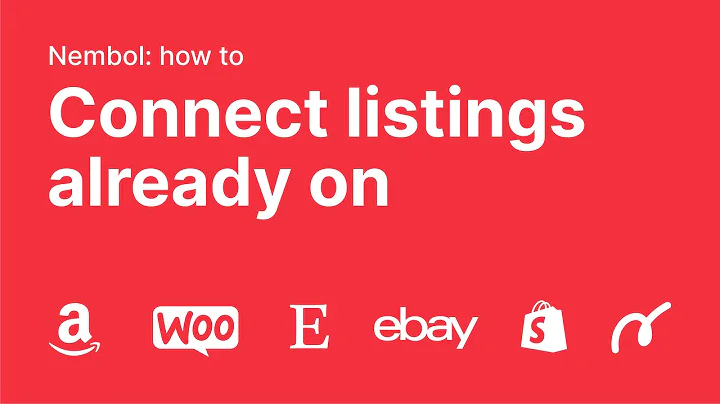Shopify vs Amazon: Which Platform Will Skyrocket Your Sales?
Table of Contents:
- Introduction
- Shopify versus Amazon: An Overview
- Ease of Use
- Pricing
- Payment Options
- Design Flexibility
- Customer Support
- Selling Features and Tools
- Traffic and Sales
- Search Engine Optimization
- Conclusion
Introduction
In this article, we will be comparing two popular e-commerce platforms, Shopify and Amazon. Both platforms have their pros and cons, and it is important to understand these differences before deciding which one to use for your online business. We will discuss various aspects such as ease of use, pricing, payment options, design flexibility, customer support, selling features and tools, traffic and sales, and search engine optimization. By the end of this article, you will have a clear understanding of which platform is better suited for your specific needs.
Shopify versus Amazon: An Overview
Shopify and Amazon are two of the leading players in the e-commerce world. While both platforms allow you to display your products in front of millions of potential customers, they differ in terms of their services. Shopify is an e-commerce platform that enables you to build an online store without any coding skills. On the other hand, Amazon is an online marketplace where you can sell your products alongside other sellers. In this article, we will compare Shopify and Amazon in detail based on various factors to help you make an informed decision on which platform to choose for your e-commerce business.
Ease of Use
When it comes to ease of use, starting to sell on Amazon is much simpler than setting up a Shopify store. With Amazon, you only need to register for an account and list your products. They provide a user-friendly interface and a guided setup process. Shopify, on the other hand, requires more steps such as setting up your domain, theme, shipping, and payment provider. While both platforms are intuitive and offer tutorials, Amazon wins in terms of ease of use, especially for beginners.
Pricing
The cost of getting started on Shopify versus Amazon depends on your sales volume. Amazon's individual seller's account has no monthly fees, but you pay 99 cents per item sold. The professional plan, at $39.99 per month, provides access to advanced tools. In addition to these fees, Amazon charges a referral fee for each product sold, usually around 15%. If you opt for fulfillment by Amazon (FBA), there are separate fees depending on the weight, size, and time of year. Shopify offers a 14-day free trial and pricing plans ranging from $29 to $2,000 per month. While Shopify can be more expensive initially, it becomes a cheaper alternative for larger sales volumes. Overall, the cost comparison between Shopify and Amazon varies based on your specific needs and sales volume.
Payment Options
In terms of payment options, Shopify offers much more flexibility than Amazon. Shopify supports over 100 payment gateways including PayPal, Stripe, and Apple Pay. They also have their own payment gateway called Shopify Payments, which does not charge any transaction fees. On the other hand, Amazon has limited payment options. They have their own in-house gateway called Amazon Pay, which accepts only credit card and debit card payments. Shopify's extensive payment options and flexibility make it the winner in this category.
Design Flexibility
Shopify provides significantly more design flexibility compared to Amazon. With Shopify, you have full control over your website's design, branding, and product display. They offer a wide range of themes and templates that can be customized to create a professional-looking online store. In contrast, Amazon offers limited customization options, and all product listings have a similar layout and design. While uniformity makes it easy to create listings, it makes it difficult for sellers to differentiate themselves from the competition. Shopify wins hands down in terms of design flexibility, allowing you to create a unique brand identity.
Customer Support
When it comes to customer support, Shopify excels compared to Amazon. Shopify offers 24/7 phone and email support, along with a comprehensive help center, articles, tutorials, and guides. Their support options include live chat, email, social media, and advanced specialist support. In contrast, Amazon outsources their customer support, and it can be challenging to reach a support representative. They rely on forums, help pages, and tutorials for issue resolution. Overall, Shopify's extensive support options and availability make it the clear winner in terms of customer support.
Selling Features and Tools
Shopify offers more e-commerce selling features and tools compared to Amazon. Shopify provides tools like abandoned cart recovery, inventory tracking, coupons and discounts, point of sale integration, and customer loyalty programs, among others. With Shopify's app store, you have access to over 7,000 apps that enhance your selling capabilities. On the other hand, Amazon's standout feature is fulfillment by Amazon (FBA), which handles storage, packing, and shipping of your products. While both platforms have their unique set of features and tools, it is a tie in this category as they cater to different aspects of e-commerce.
Traffic and Sales
Amazon has a significant advantage over Shopify when it comes to generating traffic and sales. With 2.45 billion monthly visitors in the US alone, Amazon provides instant exposure to a massive audience. However, the competition on Amazon is fierce, and it can be challenging to stand out. Shopify, on the other hand, requires you to generate your own traffic and sales through marketing strategies like Google ads, Facebook ads, SEO, and email marketing. While learning these skills takes time, Shopify provides marketing tools to attract repeat business. In terms of sheer traffic and sales, Amazon wins hands down due to its massive customer base.
Search Engine Optimization
Amazon has a significant advantage over Shopify in terms of search engine optimization (SEO). Amazon's high domain authority allows its product listings to rank on the front page of Google right away. Additionally, Amazon runs its own search engine that drives traffic and sales. Shopify, in contrast, requires you to optimize your web pages and content for search engines, which can be time-consuming. While understanding both Amazon SEO and Google SEO is crucial for success, Amazon wins in terms of SEO due to its existing authority and visibility.
Conclusion
In conclusion, the best e-commerce platform for you depends on your specific needs and goals. Shopify is suitable for those who want to build their own brand, have design flexibility, and take control of their website. It requires more effort in terms of marketing and generating traffic. Amazon, on the other hand, is ideal for those who want to make money quickly, have a limited budget, and leverage the traffic and reputation of the platform. Ultimately, a recommended approach is to start with selling on Amazon to validate your products and then transition to a Shopify store to establish your brand. It is also beneficial to sell on both platforms to maximize your sales and reach.






















